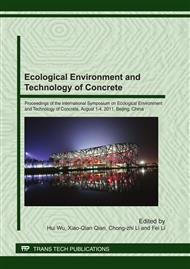p.388
p.393
p.398
p.404
p.411
p.418
p.425
p.432
p.438
Determination of the Apparent Activation Energy of Concrete by Adiabatic Test
Abstract:
It is known that apparent activation energy of the binders in concrete characterizes the sensitivity of concrete hydration processes to temperature. In this paper the apparent activation energies of concretes containing different complex binders have been determined through adiabatic temperature rise test. The influence of hydration emission heat on the apparent activation energy of concrete is studied. The study results show that the apparent activation energy is decreasing with the hydration of binder stage development.
Info:
Periodical:
Pages:
411-417
Citation:
Online since:
April 2011
Authors:
Keywords:
Price:
Сopyright:
© 2011 Trans Tech Publications Ltd. All Rights Reserved
Share:
Citation:


